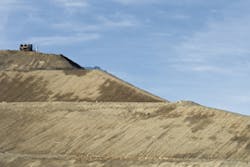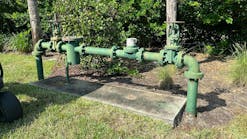The measure to address this problem is alternative daily cover (ADC), which is typically defined by regulators as cover material other than earthen material placed on the surface of the active face of a municipal solid waste landfill at the end of each operating day. These alternatives, like soil application, have the purpose of controlling vectors, fires, odors, blowing litter, and scavenging. Generally, these materials must be processed so that they do not allow gaps in the exposed landfill face. The use of alternative daily covers (ADCs) such as manually placed tarps, machine-placed tarps, films, waste-derived ADC, slurry-based ADC, and foam-based materials at landfills has increased significantly in recent years. Many state and provincial governments have supported the use of ADCs for landfills through enactment of regulations and alternative demonstration permits.
Wastech Services Ltd. is a Canadian company with more than 30 years of experience in the solid waste and recycling industry and is ISO14001 certified for its Environmental Management System. Based in Coquitlam, BC, Wastech operates five transfer and recycling facilities on behalf of the Metro Vancouver Regional District and owns and operates the Cache Creek Landfill in co-operation with the Village of Cache Creek. The Cache Creek Landfill has been in operation since 1989, primarily providing disposal capacity to Metro Vancouver. The landfill is nearing the end of its life, with over 9.3 million tons in place. At the current rate, the landfill is scheduled to reach capacity at the end of 2016.
SCS Engineers was engaged by Wastech to evaluate the feasibility of implementing an ADC program as a means to maximize the use of the available disposal capacity, reduce operating costs, and minimize the use of excavated soils from the neighboring borrow area. The airspace consumed by the typical 6 inches of daily cover over a workface, when added up over the years, significantly reduces the life of a landfill.
As defined by most landfill regulations, a continuous cover barrier must be applied over the top of disposed solid waste within a municipal waste disposal unit in North America at the end of each operating day. For example, this requirement in British Columbia ([ITALIC]Landfill Criteria for Municipal Solid Waste, B.C. Ministry of Environment) usually stipulates that owners or operators of municipal waste disposal units must cover disposed solid waste with 6 to 12 inches of earthen material, which is either available at the landfill site or imported at the end of each operating day. This daily cover soil requirement, a general standard in most North American locations, is based upon an old observation that fly larvae are incapable of “escaping” through this thickness of soil. In general, disease vectors are insects-flies and mosquitoes-but the application of this rule now generally includes birds (particularly sea gulls) rats, mice, swine, and dogs.
To effectively control disease vectors, the ADC material must prevent access to the waste and minimize the potential for the waste to serve as a food source for birds, insects, or rodents. Tarps/geotextiles are obviously a physical barrier to flies and mosquitoes, birds, rats, and probably most dogs if the tarps/geotextiles are applied properly, with specific attention to covering the edges with soil. Further, to control fires, the ADC material must be deployed to limit exposure of combustible materials to ignition sources and hinder the spread of fire if the disposed waste burns.
ADC Materials
For the purposes of our preliminary study at Wastech’s Cache Creek Landfill, ADCs were divided into various types commonly noted in regulations in North America. These include those that are specifically manufactured, such as tarps, films, foams, and sprays, while other ADCs that are waste-derived include such items as greenwaste, shredded tires, or sludge. Commercially available ADCs can be further divided into two types: materials that are sprayed on the landfill’s workface, and materials that consist of some type of fabric cover that is laid over the workface. While there is a wide variety of spray and fabric covers with different properties, all commercially available ADCs fall into these two broad categories.
Automotive shredder residue-Automotive shredder residue (ASR) is defined as the material left over after automobiles are shredded. Typically, ASR contains a variety of shredded non-metallic materials, including fabric, dirt, foam rubber, wire, plastic, wood, rubber, and paper. A 2009 survey conducted by the California Integrated Waste Management Board found that 40 states had either approved or would likely approve ASR for use as an ADC.
ASR has all the advantages of most ADCs, and has reportedly been received favorably by many landfill operators. On the negative side, there are concerns about the quality of ASR, particularly in terms of potential contamination by such automotive liquids as gasoline, brake fluid, coolant, and PCBs.
Construction-and-demolition debris-Construction-and-demolition (C&D) debris is typically defined as solid waste resulting from construction, destruction, or renovation of structures, including waste from associated land-clearing activities. Recent estimates indicate that close to 20% of the solid wastestream consists of C&D debris.
Geosynthetic covers-The use of degradable polyethylene films as ADC has been approved in many states to provide an impermeable barrier. Typically, such films are engineered to degrade by heat or mechanical stress, and not just ultraviolet light. (Degradable polyethylene films are classified by the American Society for Testing and Materials (ASTM) Standard D6523-00 “Standard Guide for Evaluation and Selection of Alternative Daily Covers (ADCs) for Sanitary Landfills,” as non-reusable geosynthetics, which are less durable disposable films or fabrics intended to be left in place without retrieval). A few contain patented additives that enable the polyethylene film to undergo thermo-oxidative degradation at elevated temperatures (greater than 35°C). The remaining fragments are subject to anaerobic biodegradation. Further, mechanical stress (i.e., induced when the film is pulled from the roll during application or stretched during differential settlement of waste) results in additional degradation.
Typically, these covers are a three-part system, consisting of the degradable cover material, a “deployer” unit, and a method of application, which dispenses the material for anchoring to the landfill’s workface. The cover material is normally applied in 10- to 18-foot-wide panels, which are overlapped by approximately 6 to 18 inches, and then securely anchored by ballast material. The overlapped panels provide a continuous barrier to isolate the various waste and disease barriers.
Tarpaulins-Tarps are widely used as an alternative to natural soil as daily cover on landfills. Instead of placing the typical 6-inch layer of borrow soil, the high-density polyethylene-coated fabric tarps can be placed at the end of each workday and then removed at the beginning of the work shift the next morning. At smaller landfills, the standard 48-foot-by-50-foot tarp, which weighs approximately 200 pounds, can be pulled on and off the workface by two men in less than 10 minutes. At larger landfills, “D rings” have been attached to excavator equipment to maneuver the cover on and off each day. Under such daily use conditions, common industry experience suggests that the tarps can last two years or more.
Foam-A variety of different long-duration foams are being applied at landfill workfaces as ADC. Typically, these ADC foams are made by mixing chemicals and water onsite and utilizing compressed air to apply a biodegradable foam blanket. When covered by waste the following day the waste compresses the foam to the point that it occupies virtually no airspace. Several suppliers have developed a number of proprietary, commercialized applications including the foam concentrate (AC-667-SE, “Soil Equivalent Foam,” is a liquid concentrate comprised of a starch-modified hydrolyzed protein surfactant, which is delivered in bulk quantity and diluted with water prior to application) and the required pneumatic foam units for applying the foam. The application equipment can be provided as either a trailer-mounted unit or a self-propelled unit having Caterpillar components. These units are designed to distribute a 12-foot wide foam blanket with a bi-directional manifold. Using such equipment, the manufacturer indicates that a typical 15,000-square-foot workface (three to four inches) can be foamed in about 30 minutes with one operator.
Slurry-Similarly, several manufacturers have developed ADCs by blending recycled fibers and polymers, which creates a slurry when mixed with water or leachate. This mix can be sprayed over a landfill workface, providing a one-eighth-inch to one-quarter-inch layer between the solid waste and the environment.
A few manufacturers have designed a unique sprayer to address the viscosity of the slurry.
The Cache Creek Landfill
The Wastech Cache Creek Landfill is located in an area of low precipitation (230 mm per year) and high evapotranspiration, thus minimizing leachate generation. Ninety-five percent of the waste tonnage received at the landfill is from British Columbia’s lower mainland area, located in the southwest corner of the province. This is a highly populated area (population approximately 2.3 million) around Vancouver and includes cities such as North Vancouver, Surrey, Burnaby, and Coquitlam. Waste arrives in Super-B train transfer trailers with approximately 41 tons total capacity pulled by liquefied natural gas (LNG) powered tractors. These trailers are unloaded at the landfill using a mobile landfill transfer trailer tipper. This unit is stationary during the unloading of the trailers and is moved by operators as the workface advances.
The landfill has been developed and operated in a number of stages and substages utilizing what has been described as a “hillside” or “above-grade modified area fill.” This type of landfilling method generates a staircase-like appearance as benches are developed across the site. At each stage, a temporary access road is constructed allowing the waste transport vehicles access to tipping area. Additionally, the landfill operator also constructs temporary visual berms and ditches, as required for proper operations. Once the final elevations are achieved, a final cover is placed over this area.
Waste delivered to the landfill is placed in 3-meter lifts. For each lift, the waste is spread and compacted on the workface in a maximum of 600-millimeter layers, utilizing a landfill compactor. The workface is normally kept to a width of approximately 30 meters to facilitate odor control, bird and vector control, and litter control.
Compaction and Coverage
Historically, Wastech has operated the landfill 24 hours per day. Under this operating regime, no daily cover is required, as waste is being covered continuously as each lift is built. In 2011, as a result of decreasing flows to the landfill, operations were reduced to day shift only. Under Wastech’s operating permit, waste cannot remain uncovered for more than 24 hours, and the use of daily cover was started.
In reviewing the opportunity for replacement of daily soil cover, Wastech identified the workface at the landfill to be roughly 30 meters by 15 meters (450 square meters). The geometry of each lift slopes down approximately 3:1. Operators place cover soil on both the top and the edge of each lift. Thus, when the next cell is started, a “sliver” of cover is placed diagonally through each lift, which could be eliminated if an alternative cover is utilized, resulting in a 45% decrease in soil cover requirements.
Geometry of the Fill
Cost of Cover Operations
Subsequent to the site visit, landfill staff worked with company accountants to develop an estimate of the current cost of landfill cover. While the volume of cover may change from time to time, fluctuating with waste tonnage received by the landfill in the future, the average landfill cover cost is not projected by staff to change significantly.
Pro Forma Modeling
Based on the work performed by SCS, Wastech was able to confirm that switching from soil cover to ADC would result in reduced operating costs and an increase in the available airspace at Cache Creek. Given the desire to increase the available airspace, ADC systems that merely displace soil cover volume with another material were discarded from consideration, focusing on tarps (both film and removable) and sprays. In order to develop a cost-benefit analysis for application of three different alternative landfill cover technologies (spray-applied and tarp systems), it is important to utilize current cost information for landfill operations as noted in the paragraphs below. The economic pro forma model included these important facets.
Step 1-Identify and calculate the hourly cost of landfill equipment. This included identification of the hourly cost of every piece of landfill equipment involved in the landfill cover process.
Step 2-Determine the current cost of placing cover soil. This step included calculating the current cost of placing cover soil at the landfill. It started by quantifying the average surface area covered by landfill operations staff each day, how much soil is used, and then calculates a total cost.
Step 3-Calculating the cost of the alternative cover material. This step included calculating the cost of utilizing an alternative cover material in lieu of the traditional soil material.
Model Inputs
Capital costs-The major capital costs for the equipment deployers were amortized over an estimated seven-year depreciation schedule. For the tarp system, SCS added in the cost of replacement tarps over this period, estimating that the tarps would have to be replaced every two years, assuming best operating practices.
Operating costs-In discussions with the equipment manufacturers, estimates were made of the daily cost of the deploying equipment (e.g., mix and application of the spray material, tarps, and placement of the polyethylene). These were entered into the model along with the daily cost of these materials (e.g., aggregate, coloring, and polyethylene film). Estimated freight costs were provided by the manufacturers for chemicals and polyethylene film and were included in the daily operational costs, taking into account possible quantity discounts because of Cache Creek Landfill’s distant location.
Model results-Actual quotes from the different manufacturers were used in developing this cost-benefit analysis. The additional landfill airspace would potentially add an additional 104 days in landfill capacity, or an additional 61 tontonns per day while maintaining the forecast closure date.
Further, the model concluded that the operating costs for the ADC systems considered were lower, or at least equal, to the use of soil cover. Preliminary capital costs solicited from ADC suppliers were used by Wastech to determine a payback on capital and the net economic benefits expected.
Regulatory approval-Wastech received approval from the BC Ministry of Environment in April 2012 to implement ADC at Cache Creek. As part of that approval, Wastech was to monitor any changes to wildlife behavior in the area to and ensure that there was no attraction to the landfill resulting from the use of ADC.
Next Steps by Wastech
After identifying the various ADC systems that met the business needs, Wastech elected to pursue a competitive proposal process to confirm the capital costs, operating costs and operational compatibility of each system with the Cache Creek Landfill. Part of this process will be to discuss the merits and challenges of ADCs with various references and to determine lessons learned and best practices in the successful implementation of ADC systems in an arid environment similar to Cache Creek.
Summary
SCS developed a model for evaluating the operating and capital cost savings and airspace value that clients can use to evaluate the benefits of different ADC products. This model was applied at Wastech for the Cache Creek Landfill. The results of the financial model were combined with other business factors, such as environmental impact and the operating environment of the facility, to support a switch from soil cover to ADC. At the time of writing, Wastech has received the necessary approvals to switch to an ADC at its Cache Creek Landfill and is going through a procurement process for an ADC to help maximize the remaining life of the landfill.






